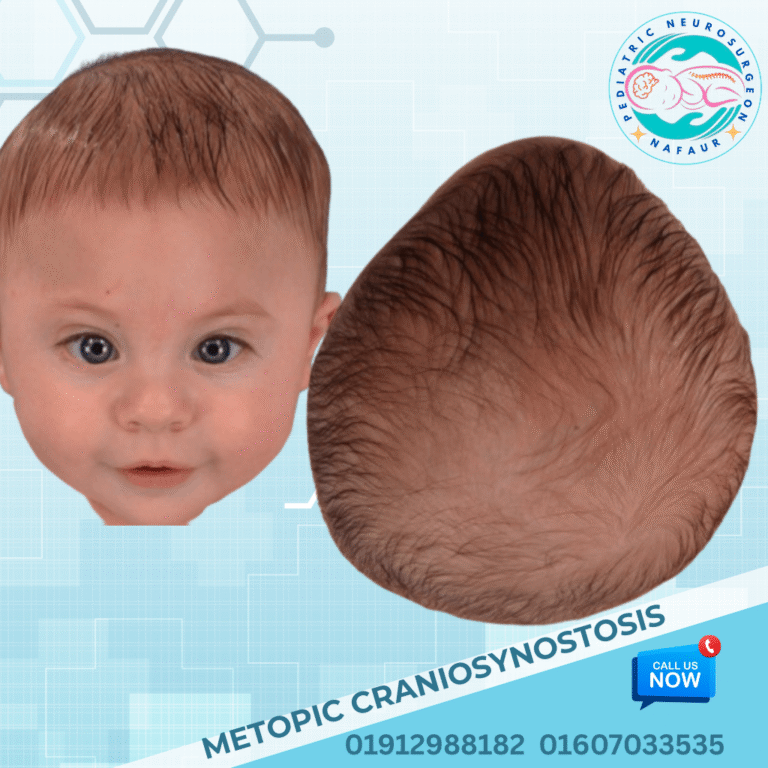Metopic Synostosis (Trigonocephaly)
Metopic Synostosis (Trigonocephaly)
Metopic synostosis, also known as trigonocephaly, is a form of craniosynostosis characterized by the premature fusion of the metopic suture, the joint running from the top of the nose up to the forehead’s midline. This early fusion restricts the transverse growth of the frontal bones, leading to a characteristic triangular-shaped forehead and a narrow, keel-shaped forehead. Trigonocephaly is less common than sagittal or coronal synostosis but presents distinct clinical and cosmetic challenges. If untreated, it can lead to functional issues, including potential neurodevelopmental delays and increased intracranial pressure. 🌍 Metopic Synostosis in the Bangladesh Context In Bangladesh, awareness and early diagnosis of metopic synostosis are still evolving, with challenges including: Limited newborn screening for cranial abnormalities in rural areas Cultural acceptance of unusual head shapes delaying medical consultation Centralized pediatric neurosurgical services mostly in Dhaka and major cities Growing expertise at National Institute of Neurosciences & Hospital (NINS) and Bangladesh Paediatric Neurocare Centre improving early detection and care Importance of early surgical intervention to optimize cosmetic and neurological outcomes ⚠️ Causes and Risk Factors Premature fusion of the metopic suture during fetal skull development Genetic factors influencing skull growth and suture biology Environmental contributors such as maternal nutritional deficiencies and exposures Occasionally associated with syndromes like trigonocephaly syndromes or other craniofacial anomalies 🧒 Signs and Symptoms Distinctive triangular-shaped forehead with a midline ridge palpable along the metopic suture Narrowing of the forehead causing hypotelorism (closely spaced eyes) in severe cases Decreased width of the frontal region and sometimes orbital deformities Potential developmental delays or learning difficulties in more severe or untreated cases Rare symptoms of increased intracranial pressure such as headaches, vomiting, or irritability 🔍 Diagnosis and Imaging Detailed clinical examination by pediatric neurosurgeon Skull X-rays showing fusion of the metopic suture and characteristic skull shape CT scan with 3D reconstruction for precise anatomical assessment and surgical planning MRI brain imaging to evaluate for associated brain abnormalities if developmental concerns arise Genetic counseling and evaluation if syndromic features are suspected 🛠️ Surgical Treatment Options Surgical correction is the definitive treatment for metopic synostosis and is ideally performed between 3 and 12 months of age to allow normal brain growth and improve skull shape. Surgical Goals: Release the fused metopic suture to restore skull growth Reshape the forehead to a normal, rounded contour Correct orbital deformities and improve facial symmetry Prevent or relieve increased intracranial pressure if present Minimize surgical risks and optimize cosmetic outcomes Common Surgical Procedures: Fronto-Orbital Remodeling Reshaping of the forehead and orbital bones to correct trigonocephaly Bone grafting and contouring for improved skull symmetry Minimally Invasive Endoscopic Surgery For select infants diagnosed very early Followed by postoperative helmet therapy to guide skull remodeling 🏥 Postoperative Care and Follow-Up Hospital stay of approximately 5–7 days depending on surgical complexity Pain management and infection prevention Postoperative imaging to assess skull shape and brain status Helmet therapy in selected cases to aid skull reshaping Neurodevelopmental monitoring and support Multidisciplinary follow-up with neurosurgery, pediatrics, and rehabilitation services 🔄 Prognosis and Long-Term Outcome Early surgical intervention leads to excellent cosmetic and functional results Normalization of head shape improves psychosocial development Minimizes risk of intracranial hypertension and associated neurological complications Lifelong follow-up recommended for syndromic or complicated cases Children generally achieve normal neurodevelopment with timely treatment 👨⚕️ Why Trust Dr. Md. Nafaur Rahman? Expert in complex pediatric craniofacial and skull base surgeries Extensive experience treating craniosynostosis at National Institute of Neurosciences & Hospital (NINS) Chief Consultant at Bangladesh Paediatric Neurocare Centre, delivering multidisciplinary care Uses latest surgical and imaging technologies adapted for Bangladesh’s healthcare environment Provides compassionate, family-focused guidance from diagnosis to long-term care 📞 Book a Consultation for Metopic Synostosis (Trigonocephaly) in Bangladesh Dr. Md. Nafaur Rahman Assistant Professor, Pediatric Neurosurgery, NINS Chief Consultant, Bangladesh Paediatric Neurocare Centre 📞 Call for appointments: 01912988182 | 01607033535 🌐 Visit: www.neurosurgeonnafaur.com












